/en/excel2013/freezing-panes-and-view-options/content/
Introduction
As you add more content to a worksheet, organizing this information becomes especially important. You can quickly reorganize a worksheet by sorting your data. For example, you could organize a list of contact information by last name. Content can be sorted alphabetically, numerically, and in many other ways
Types of sorting
When sorting data, it's important to first decide if you want the sort to apply to the entire worksheet or just a cell range.
- Sort sheet organizes all of the data in your worksheet by one column. Related information across each row is kept together when the sort is applied. In the example below, the Contact Name column (column A) has been sorted to display the names in alphabetical order.
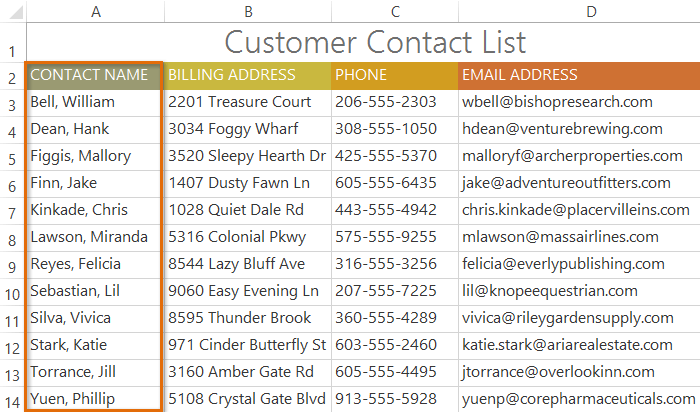 Sorting a sheet
Sorting a sheet
- Sort range sorts the data in a range of cells, which can be helpful when working with a sheet that contains several tables. Sorting a range will not affect other content on the worksheet.
 Sorting a cell range
Sorting a cell range
To sort a sheet:
In our example, we'll sort a T-shirt order form alphabetically by Last Name (column C).
- Select a cell in the column you want to sort by. In our example, we'll select cell C2.
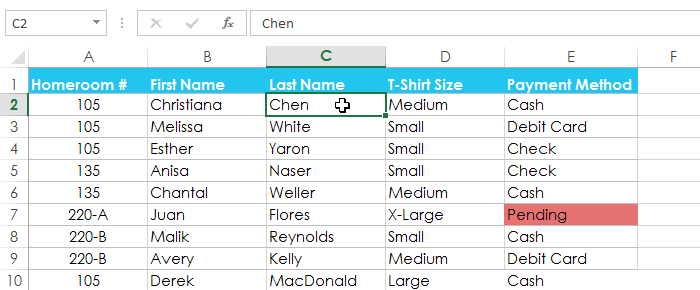 Selecting cell C2
Selecting cell C2 - Select the Data tab on the Ribbon, then click the Ascending command
 to Sort A to Z, or the Descending command
to Sort A to Z, or the Descending command  to Sort Z to A. In our example, we'll click the Ascending command.
to Sort Z to A. In our example, we'll click the Ascending command.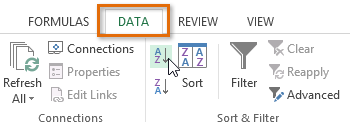 Clicking the Ascending command
Clicking the Ascending command - The worksheet will be sorted by the selected column. In our example, the worksheet is now sorted by last name.
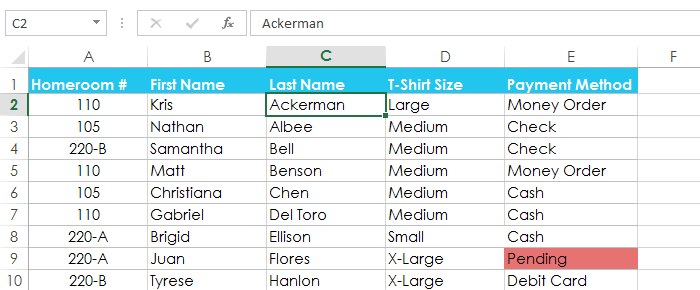 The sorted worksheet
The sorted worksheet
To sort a range:
In our example, we'll select a separate table in our T-shirt order form to sort the number of shirts that were ordered on different dates.
- Select the cell range you want to sort. In our example, we'll select cell range A13:B17.
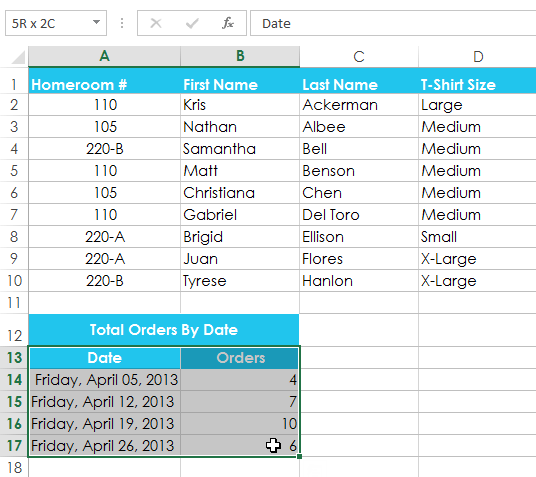 Selecting cell range A13:B17
Selecting cell range A13:B17
- Select the Data tab on the Ribbon, then click the Sort command.
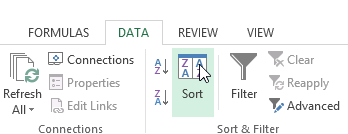 Clicking the Sort command
Clicking the Sort command - The Sort dialog box will appear. Choose the column you want to sort by. In our example, we want to sort the data by the number of T-shirt orders, so we'll select Orders.
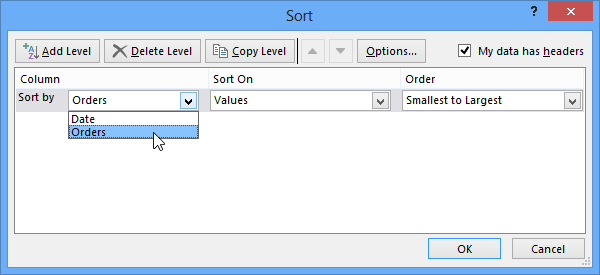 Selecting a column to sort by
Selecting a column to sort by - Decide the sorting order (either ascending or descending). In our example, we'll use Smallest to Largest.
- Once you're satisfied with your selection, click OK.
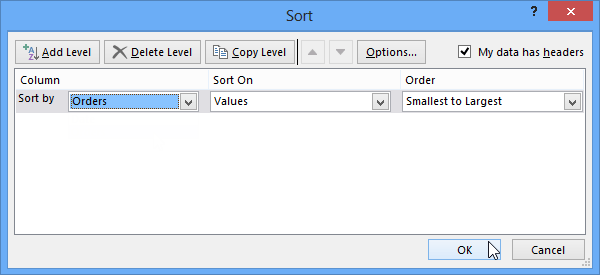 Clicking OK
Clicking OK - The cell range will be sorted by the selected column. In our example, the Orders column will be sorted from lowest to highest. Notice that the other content in the worksheet was not affected by the sort.
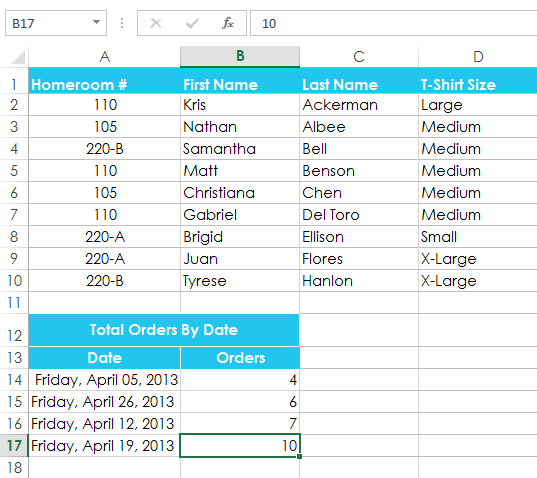 The sorted cell range
The sorted cell range
If your data isn't sorting properly, double-check your cell values to make sure they are entered into the worksheet correctly. Even a small typo could cause problems when sorting a large worksheet. In the example below, we forgot to include a hyphen in cell A18, causing our sort to be slightly inaccurate.
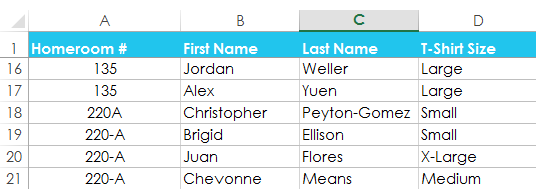 A small typo in cell A18 causing an incorrect sort
A small typo in cell A18 causing an incorrect sort
Custom sorting
Sometimes you may find that the default sorting options can't sort data in the order you need. Fortunately, Excel allows you to create a custom list to define your own sorting order.
To create a custom sort:
In our example below, we want to sort the worksheet by T-Shirt Size (column D). A regular sort would organize the sizes alphabetically, which would be incorrect. Instead, we'll create a custom list to sort from smallest to largest.
- Select a cell in the column you want to sort by. In our example, we'll select cell D2.
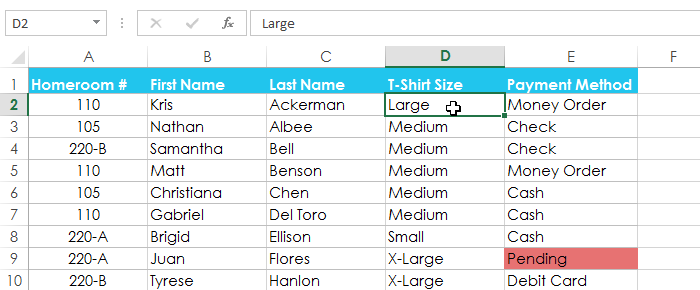 Selecting cell D2
Selecting cell D2 - Select the Data tab, then click the Sort command.
 Clicking the Sort command
Clicking the Sort command - The Sort dialog box will appear. Select the column you want to sort by, then choose Custom List... from the Order field. In our example, we will choose to sort by T-Shirt Size.
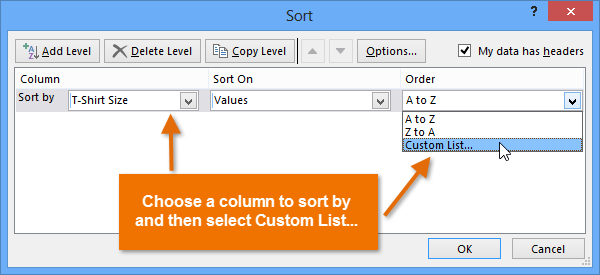 Selecting Custom List... from the Order: field
Selecting Custom List... from the Order: field - The Custom Lists dialog box will appear. Select NEW LIST from the Custom Lists: box.
- Type the items in the desired custom order in the List entries: box. In our example, we want to sort our data by T-shirt size from smallest to largest, so we'll type Small, Medium, Large, and X-Large, pressing Enter on the keyboard after each item.
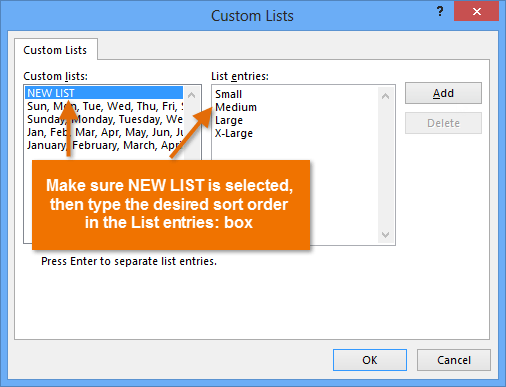 Creating a Custom list
Creating a Custom list - Click Add to save the new sort order. The new list will be added to the Custom lists: box. Make sure the new list is selected, then click OK.
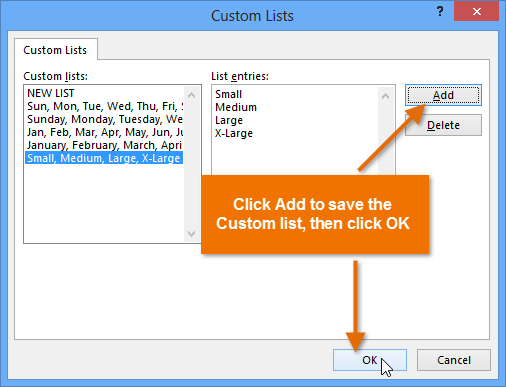 Clicking OK to select the custom list
Clicking OK to select the custom list - The Custom Lists dialog box will close. Click OK in the Sort dialog box to perform the custom sort.
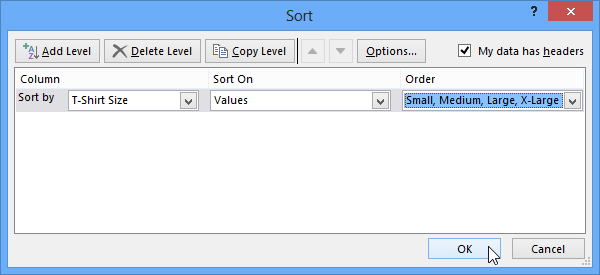 Clicking OK to sort the worksheet
Clicking OK to sort the worksheet - The worksheet will be sorted by the custom order. In our example, the worksheet is now organized by T-shirt size from smallest to largest.
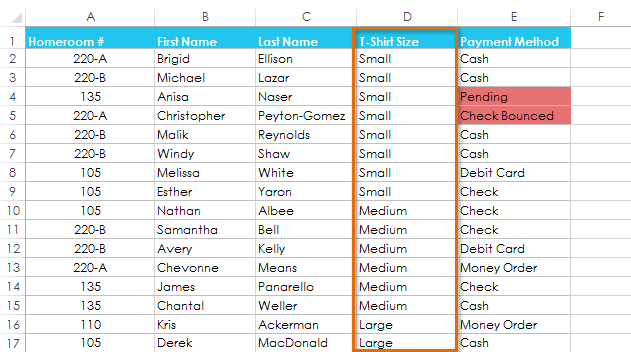 The worksheet sorted by t-shirt size
The worksheet sorted by t-shirt size
To sort by cell formatting:
You can also choose to sort your worksheet by formatting rather than cell content. This can be especially helpful if you add color coding to certain cells. In our example below, we'll sort by cell color to quickly see which T-shirt orders have outstanding payments.
- Select a cell in the column you want to sort by. In our example, we'll select cell E2.
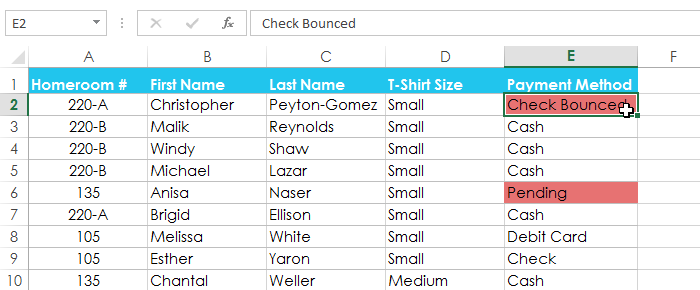 Selecting cell E2
Selecting cell E2 - Select the Data tab, then click the Sort command.
 Clicking the Sort command
Clicking the Sort command - The Sort dialog box will appear. Select the column you want to sort by, then decide whether you'll sort by Cell Color, Font Color, or Cell Icon from the Sort On field. In our example, we'll sort by Payment Method (column E) and Cell Color.
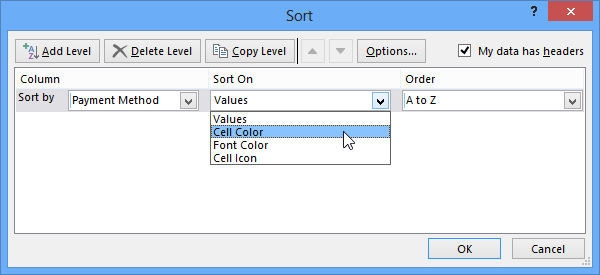 Choosing to sort by cell color
Choosing to sort by cell color - Choose a color to sort by from the Order field. In our example, we'll choose light red.
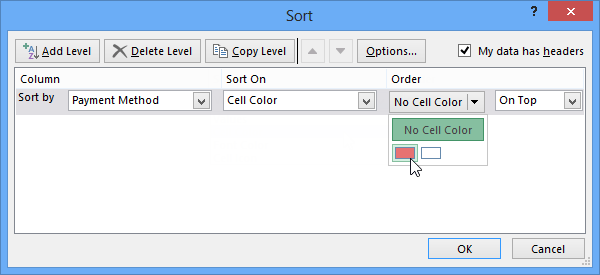 Choosing a cell color to sort by
Choosing a cell color to sort by - Click OK. In our example, the worksheet is now sorted by cell color, with the light red cells on top. This allows us to see which orders still have outstanding payments.
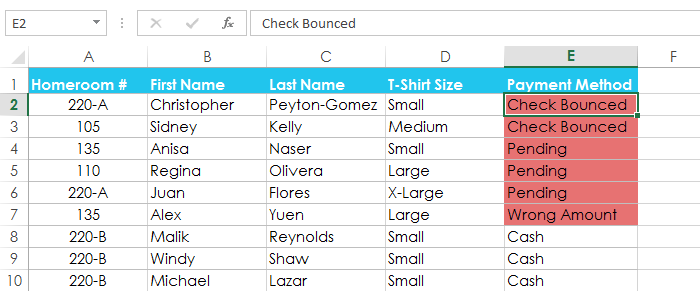 The worksheet sorted by cell color
The worksheet sorted by cell color
Sorting levels
If you need more control over how your data is sorted, you can add multiple levels to any sort. This allows you to sort your data by more than one column.
To add a level:
In our example below, we'll sort the worksheet by Homeroom Number (column A), then by Last Name (column C).
- Select a cell in the column you want to sort by. In our example, we'll select cell A2.
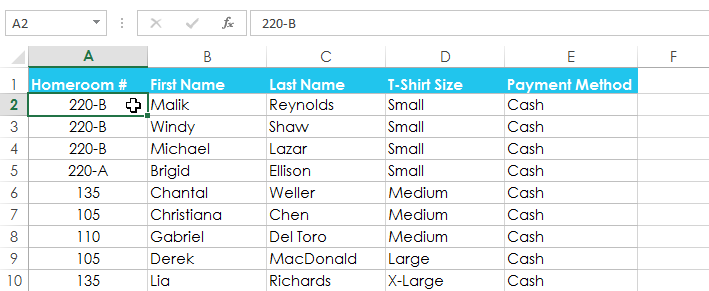 Selecting cell A2
Selecting cell A2 - Click the Data tab, then select the Sort command.
 Clicking the Sort command
Clicking the Sort command - The Sort dialog box will appear. Select the first column you want to sort by. In this example, we will sort by Homeroom # (column A).
- Click Add Level to add another column to sort by.
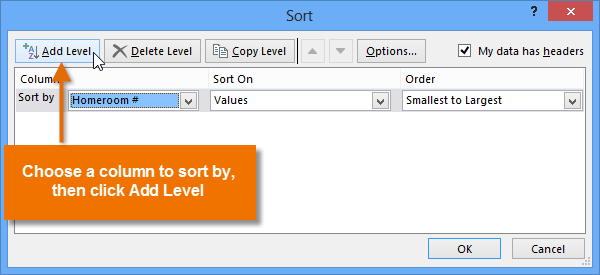 Clicking Add Level
Clicking Add Level - Select the next column you want to sort by, then click OK. In our example, we'll sort by Last Name (column C).
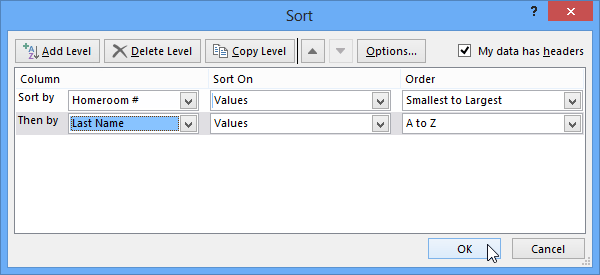 Sorting by Homeroom # and Last Name
Sorting by Homeroom # and Last Name - The worksheet will be sorted according to the selected order. In our example, the homeroom numbers are sorted numerically. Within each homeroom, students are sorted alphabetically by last name.
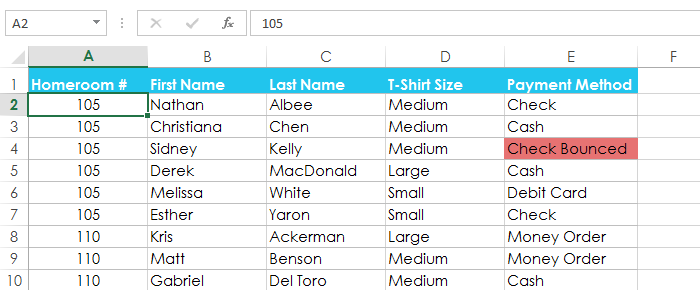 The worksheet sorted by homeroom number and last name
The worksheet sorted by homeroom number and last name
If you need to change the order of a multilevel sort, it's easy to control which column is sorted first. Simply select the desired column, then click the Move Up or Move Down arrow to adjust its priority.
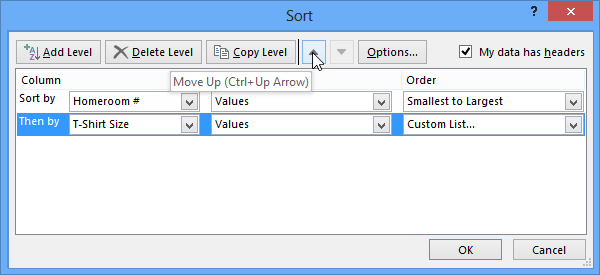 Changing the sorting priority for a column
Changing the sorting priority for a column
Challenge!
- Open an existing Excel workbook. If you want, you can use our practice workbook.
- Sort a worksheet in ascending
 or descending
or descending  order. If you are using the example, sort by Homeroom # (column A).
order. If you are using the example, sort by Homeroom # (column A). - Sort a cell range. If you are using the example, sort the cell range in the cell range G3:H7 from highest to lowest by Orders (column H).
- Add a level to the sort, and sort it by cell color, font color, or cell icon. If you are using the example, add a second level to sort by cell color in column E.
- Add another level, and sort it using a custom list. If you are using the example, create a custom list to sort by T-Shirt Size (column D) in the order of Small, Medium, Large, and X-Large.
- Change the sorting priority. If you are using the example, reorder the list to sort by T-Shirt Size (column D), Homeroom # (column A), and Last Name (column C).
/en/excel2013/filtering-data/content/


 Sorting a sheet
Sorting a sheet  Sorting a cell range
Sorting a cell range  Selecting cell C2
Selecting cell C2 Clicking the Ascending command
Clicking the Ascending command The sorted worksheet
The sorted worksheet Selecting cell range A13:B17
Selecting cell range A13:B17 Clicking the Sort command
Clicking the Sort command Selecting a column to sort by
Selecting a column to sort by Clicking OK
Clicking OK The sorted cell range
The sorted cell range A small typo in cell A18 causing an incorrect sort
A small typo in cell A18 causing an incorrect sort Selecting cell D2
Selecting cell D2 Clicking the Sort command
Clicking the Sort command Selecting Custom List... from the Order: field
Selecting Custom List... from the Order: field Creating a Custom list
Creating a Custom list Clicking OK to select the custom list
Clicking OK to select the custom list Clicking OK to sort the worksheet
Clicking OK to sort the worksheet The worksheet sorted by t-shirt size
The worksheet sorted by t-shirt size Selecting cell E2
Selecting cell E2 Clicking the Sort command
Clicking the Sort command Choosing to sort by cell color
Choosing to sort by cell color Choosing a cell color to sort by
Choosing a cell color to sort by The worksheet sorted by cell color
The worksheet sorted by cell color Selecting cell A2
Selecting cell A2 Clicking the Sort command
Clicking the Sort command Clicking Add Level
Clicking Add Level Sorting by Homeroom # and Last Name
Sorting by Homeroom # and Last Name The worksheet sorted by homeroom number and last name
The worksheet sorted by homeroom number and last name Changing the sorting priority for a column
Changing the sorting priority for a column